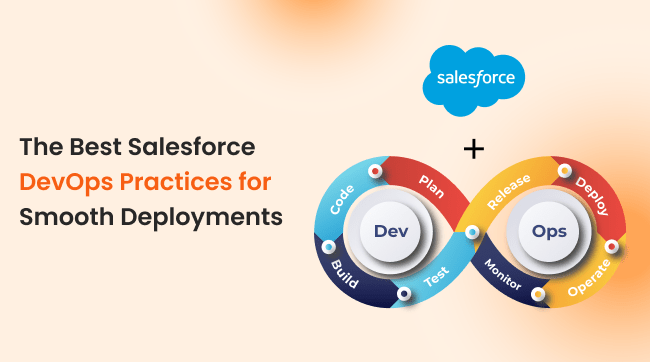DevOps is no longer a buzzword for organizations adopting digital infrastructure, but it has become essential for seamless software deployment. DevOps promotes collaboration, which lets businesses enjoy faster product releases. However, deploying changes in Salesforce can be quite tricky. With a solid strategy, the right tools, and proper planning, you can ensure a smooth deployment. With the proper deployment, users stay happy, data remains clean, and businesses run faster and smarter. Therefore, whether you’re a startup or an already established business, mastering DevOps best practices helps you boost your team’s productivity, improve deployment cycles, and customer experiences.
This blog highlights the best Salesforce DevOps practices that let businesses enjoy long-term success and a strong market position. However, before diving deep into the best practices, let us first understand what DevOps is and why it is important.
What is DevOps?
DevOps is the strategy that brings software development and operations teams together. The main goal of it is to improve collaboration and speed up the product delivery. Organizations can merge development and operations into a cohesive process and deploy more frequently. It improves their Time To Market, but keeps services stable and agile to meet market demands.
In short, DevOps’ primary goals are to accelerate software development and ensure that features and services are delivered to customers more safely, faster, and efficiently. DevOps lets teams refine processes. Therefore, they can quickly roll out new features, identify bugs, and improve the overall quality and reliability of software.
Why is DevOps Important?
The DevOps not only improve speed and efficiency, but it also reduces deployment errors through continuous testing, feedback, finding and fixing issues at an early stage. It helps in automating repetitive tasks, which frees up developers and operators. Therefore, they can focus on more strategic work.
In short, DevOps transforms deployment from a stressful process to a predictable and simplified process.
Best Salesforce DevOps Practices for Smooth Deployment
If you want to achieve a seamless and efficient Salesforce deployment, you should follow the practices discussed below. It will help you minimize risks and maximize results. Here are the best Salesforce DevOps practices for your successful deployment.
A. Make a Proper Plan Before Deployment
Each successful deployment begins with a solid plan. If you don’t have clear objectives in mind and a well-structured roadmap, your Salesforce deployment process might face unexpected obstacles. It results in long release cycles or wasted efforts. If you want to plan effectively, first clarify your goals and priorities. You must understand what you want to achieve. After that, for each stage, create a timeline with milestones. Don’t forget to list potential challenges and develop strategies to address them before they disturb the deployment.
B. Fast-track Product Delivery Via Continuous Integration and Delivery
Continuous Integration and Continuous Delivery is the backbone of modern DevOps practices. CI means regularly merging the code changes into the central repository. It helps find out and resolve conflicts early. Moreover, it simplifies the integration procedure.
CD extends CI by deploying code changes to the testing or production environment after the build stage. It guarantees reliable software release with little to no manual intervention.
CI and CD together speed up the deployment process and improve software quality and stability. It allows teams to deliver innovations rapidly and confidently.
C. Automate Tasks and Testing
When you use automation in DevOps, it completely transforms tasks and testing, save time, and mitigates errors. Routine tasks such as code compilation, environment setups, and database migrations are automated. These automated tests in continuous integration prevent new changes from breaking existing functionality.
Automation speeds up the development and delivery. It frees developers’ time and lets them focus on innovation and ensure consistent and reliable software.
D. Utilize a Sandbox Environment for Testing
A sandbox offers a secure space to experiment and validate changes. The best thing about it is that it don’t affect the live production environment. When you skip this crucial step, it can lead to errors, downtime, or disrupted workflow at the time of deployment.
The main benefit of using Sandbox is that it improves collaboration as teams can work on different deployment aspects simultaneously. You can find out issues at an early stage so that it ensures smoother deployment and production. Salesforce provides you with various sandbox options like Developer Sandbox, Partial Copy Sandbox, and Full Copy Sandboxes.
E. Make Use of Salesforce Change Sets and Deployment Tools
Salesforce provides you with excellent built-in tools, such as Change Sets, to simplify deployment. As your organization grows or faces more complicated requirements, it requires more specialized tools specifically designed for greater efficiency.
F. Prioritize Stakeholders' Involvement Early and Often
You must involve stakeholders from the start of the development process. It makes sure that your deployment aligns with the business objectives. When you involve the right people at the right time, it improves collaboration and reduces resistance, which makes the deployment process smoother. If you want to engage stakeholders effectively, you must include representatives from different departments. Besides, you must conduct regular meetings to gather feedback. You must communicate timelines and expectations clearly. It helps you improve your product.
G. Data Integrity and Security are Crucial
Data integrity and security are important for the successful Salesforce deployment. If you neglect these aspects, it can cause significant challenges which includes unauthorized access and data breaches. These issues cause severe consequences, like trust and reputation loss and legal penalties. Therefore, you must concentrate on strategies that strengthen your Salesforce data security.
H. Don’t Overlook Documentation
Detailed documentation is essential. Therefore, you should never overlook it. Troubleshooting and onboarding new team members become more challenging due to communication breakdowns. It might result in low productivity. You should document each deployment step of the Salesforce deployment process. Also, document all settings and customizations, like specific validation rules or field configurations. It makes it quite easy for someone new to understand the environment and replicate your work.
I. Keep Monitoring and Optimizing Post-Deployment
If you’re thinking that your work will stop once the deployment is complete, you’re wrong. You need to constantly monitor its performance, find out potential issues, and optimize the system to maximize its impact. In that, a robust monitoring tool becomes helpful. Post-deployment monitoring helps you find out areas for improvement early. You must conduct regular audits that ensure your system is aligned with evolving business goals and compliance requirements. Moreover, ongoing feedback provides valuable insights that drive system improvements and enhance your user experience.
Let’s OddEven Infotech Transform Your Salesforce Deployment
Salesforce deployment has its own challenges. However, if you understand these challenges and ways to mitigate them by using the proven Salesforce DevOps practices, it can provide remarkable outcomes.
These best practices reduce downtime, improve deployment processes, and ensure each change perfectly aligns with your organization goals. Whether you’re planning your first rollout or optimizing your existing process, OddEven Infotech can help you. Connect with us to schedule a free consultation with one of our Salesforce experts. They will help you make your Salesforce deployment the smoothest one.




